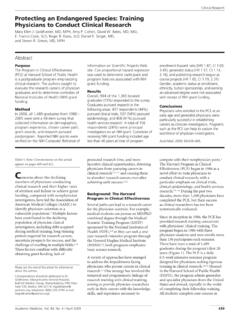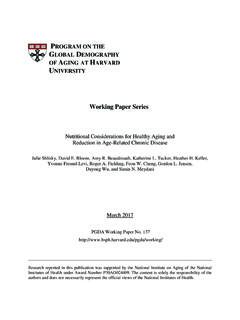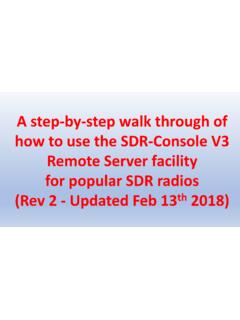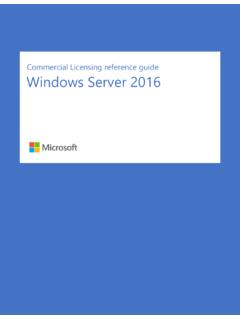Transcription of Remote Access to your Desktop using VPN - Harvard …
1 Remote Access to your Desktop using VPN. Overview VPN is a tool that enables you to Access one computer from another. Typical uses for Pop Center members would be 1) Access their pop center computer from a home computer or laptop 2) Access HSPH Kresge computers from the pop center 3) Access the HSPH network drives from a non-HSPH internet connection. To set up the VPN you need to install two software programs on the computer you connect FROM. You will also need to enable Remote Access of the computer you are going to Access TO. To start things off, put in an HSPH IT ticket and request a VPN account and a fixed IP. address of the computer you want to connect TO. If you are not a faculty member, you will have to pay $72/year for this VPN account. Once you have the email saying you can go ahead and set up VPN, you can follow the instructions below working with both the computer you want to connect TO, and the computer you connect FROM. For ease of notation, I'm going to call the computer you connect TO the office computer, and the computer you connect FROM is the home.
2 Computer. This is just notation, however, you can actually set up the VPN any way around. The initial set up takes a few steps, but then each time you want to connect it is just a two set process. Stepwise instructions Connecting from a home Windows PC to an office Windows PC. Connecting from a home Mac to an office Mac. Connecting from a home Mac to an office Windows PC. Connecting from a home Windows PC to an office Mac. Connecting from an iPad to a Mac. Connecting from an iPad to a Windows PC. Technical Details VPN is a virtual private network. The VPN protocol is how your HOME computer connects to the HSPH network. The VPN client, Cisco Anyconnect, creates a tunnel to the HSPH network, through which you can Access other computers on the HSPH. network. Before connecting with Remote Desktop software, a VPN tunnel must be established from the client HOME computer to the HSPH network. VNC is virtual network computing. The VNC protocol allows you to gain Access to the Desktop of another computer.
3 The VNC client, Tight VNC, connects to an HSPH. computer through the VPN tunnel. Mac computers have a VNC server pre-installed but Windows computers do not. To connect FROM a Windows computer to a Mac: Install Tight VNC on the Windows computer, and use the Tight VNC Viewer to connect to the Mac's IP. address. To connect from a Mac to another Mac, no additional software is required. Simply use the Finder, select Go -> Connect to server and enter the IP address of the other Mac. RDP is Remote Desktop protocol. The RDP allows you to gain Access to the Desktop of another computer. The RDP client, Remote Desktop Connection, connects to an HSPH. computer through the VPN tunnel, just like the VNC client. Windows computers have an RDP server pre-installed but Mac computers do not. To connect FROM a Mac to a Windows computer: Install Remote Desktop Client on the Mac, the go to Applications -> Remote Desktop Connection and enter the IP address of the Windows computer. To connect from a Windows computer to another Windows computer, no additional software is required.
4 Simply go to Start -> Accessories -> Remote Desktop Connection and enter the IP address of the other Windows computer. In summary: FROM Mac to Mac or Windows to Windows: Connect with VPN, then use native Remote Desktop software. From HOME Mac to OFFICE Windows: Connect with VPN, then use Remote Desktop Client. From HOME Windows to OFFICE Mac: Connect with VPN, then use VNC client. Connecting from a home Windows PC to an office Windows PC. Initial set up Let's start by setting up the OFFICE computer you want to connect TO. If the computer you want to connect to is using Windows 7 Professional, Windows 7. Ultimate, or Windows 7 Enterprise, follow these steps: 1. Go to System in the Control Panel 2. Click on Remote Settings in the top left corner 3. Click on the Remote tab 4. Then select Allow Remote Assistance connections to this computer and select Allow connections from computers running any version of Remote Desktop . In Windows XP: 1. Right-click the My Computer icon on the Desktop , and then click Properties.
5 2. Click the Remote tab. 3. Make sure that the Allow users to connect remotely to this computer check box is selected, and then click OK. You will need to request the fixed IP address for this office computer. To determine your computer's IP address, Run cmd, then type ipconfig. Record the IP address. your OFFICE computer is now set up so you can connect to it. Next, we'll set up your HOME PC. 1. Request VPN from HSPH IT provide ID #, email address, billing code 2. HSPH will send you an email with instructions for setting up your VPN account (similar to what follows:). 3. Use a web browser to log-in to 4. Download Cisco Anyconnect VPN client 5. Create tunnel: a. Go to Start -> All Programs > Cisco > Cisco Anyconnect VPN Client b. Select c. Log in with your credentials i. User: ii. Pasword: Harvard PIN. 6. In addition to the Cisco program, you will also need a Remote Desktop program to connect to the computer you want to connect to. a. In Windows XP go to: Start>All Programs>Accessories and choose Remote Desktop connection (create a shortcut on your Desktop , as you will go to this program each time you connect to your office computer).
6 Enter the IP of your office computer in the provided box and click connect. b. In Windows 7: Go to the Start menu, then search Remote Desktop . Choose the FILE named Remote Desktop . Enter the IP address of the computer you want to connect to. You will also need to enter your username and password of the computer you connect to. Connecting from your HOME PC. Each time you connect from your home PC. 1. Go to the Cisco Anyconnect VPN program, enter your HSPH PIN password, and click accept. 2. Go to Remote Desktop , your IP address should already be there from the initial setup, click connect. You should be taken to your office Desktop , maybe to your login page. Connecting from a home Mac to an office Mac. Initial set up Let's start by setting up your OFFICE Mac that you'll connect TO: 1. Configure local firewall: a. Go to System Preferences -> Security & Privacy -> Firewall b. Uncheck Block all incoming connections . c. Allow SSH, Management, Screensharing 2. Go to System preferences > Sharing a.
7 Check Remote login b. Check Remote management You will need to request the fixed IP address for this office computer. To determine your computer's IP address, open the Terminal and type ifconfig. Under your Ethernet port, en0 there should be listed inet and an IP address. Record this IP address. your OFFICE computer is now set up so you can connect to it. Next, we'll set up your HOME Mac. 1. Request VPN from HSPH IT provide ID #, email address, billing code 2. HSPH will send you an email with instructions for setting up your VPN account (similar to what follows:). 3. Use a web browser to log-in to 4. Download Cisco Anyconnect VPN client 5. Create tunnel: a. Go to Applications > Cisco > Cisco Anyconnect VPN Client b. Select c. Log in with your credentials i. User: ii. Pasword: Harvard PIN. 6. Finder > Go > Connect to server a. Enter: vnc://ip-address b. Click the + button to add the IP address to your favorites 7. Screen Sharing VNC application will open Connecting from your HOME Mac Each time you connect from your home Mac: 1.
8 Go to the Cisco Anyconnect VPN program, enter your HSPH PIN password, and click accept. 2. Go to Finder > Go > Connect to server . your IP address should already be there from the initial setup, click connect. You should be taken to your office Desktop , maybe to your login page. Connecting from a home Mac to an office Windows PC. Initial set-up Let's start by setting up the OFFICE PC computer you want to connect TO. If the computer you want to connect to is using Windows 7 Professional, Windows 7. Ultimate, or Windows 7 Enterprise, follow these steps: 1. Go to System in the Control Panel 2. Click on Remote Settings in the top left corner 3. Click on the Remote tab 4. Then select Allow Remote Assistance connections to this computer and select Allow connections from computers running any version of Remote Desktop . In Windows XP: 1. Right-click the My Computer icon on the Desktop , and then click Properties. 2. Click the Remote tab. 3. Make sure that the Allow users to connect remotely to this computer check box is selected, and then click OK.
9 You will need to request the fixed IP address for this office computer. To determine your computer's IP address, Run cmd, then type ipconfig, Record the IP address. your OFFICE computer is now set up so you can connect to it. Next, we'll set up your HOME Mac. 1. Request VPN from HSPH IT provide ID #, email address, billing code 2. HSPH will send you an email with instructions for setting up your VPN account (similar to what follows:). 3. Use a web browser to log-in to 4. Download Cisco Anyconnect VPN client 5. Create tunnel: a. Go to Applications > Cisco > Cisco Anyconnect VPN Client b. Select c. Log in with your credentials i. User: ii. Pasword: Harvard PIN. 6. In addition to the Cisco program, you will also need a Remote Desktop program. Download Microsoft RDC software from: 7. Open the RDC software by Applications > Remote Desktop Connection a. Enter the IP address of the computer you're connecting to and click Connect b. A warning dialogue will pop up, click Connect c.
10 Screen Sharing RDC application will open to the log-in of the OFFICE. computer Connecting from your HOME Mac Each time you connect from your home Mac: 1. Go to the Cisco Anyconnect VPN program, enter your HSPH PIN password, and click accept. 2. Open the RDC software by Applications > Remote Desktop Connection, enter the IP. address and connect Connecting from a home Windows PC to an office Mac Initial set up Let's start by setting up your OFFICE Mac that you'll connect TO: 1. Configure local firewall: a. Go to System Preferences -> Security & Privacy -> Firewall b. Uncheck Block all incoming connections . c. Allow SSH, Management, Screensharing 2. Go to System preferences > Sharing a. Check Remote login b. Check Remote management You will need to request the fixed IP address for this office computer. To determine your computer's IP address, open the Terminal and type ifconfig. Under your Ethernet port, en0 there should be the word inet and an IP address. Record this IP address.
















